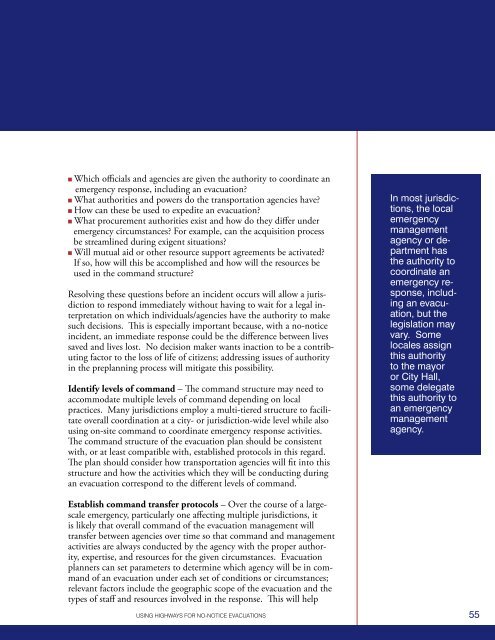using highways for no-notice evacuations - FHWA Operations - U.S. ...
using highways for no-notice evacuations - FHWA Operations - U.S. ...
using highways for no-notice evacuations - FHWA Operations - U.S. ...
You also want an ePaper? Increase the reach of your titles
YUMPU automatically turns print PDFs into web optimized ePapers that Google loves.
n Which officials and agencies are given the authority to coordinate anemergency response, including an evacuation?n What authorities and powers do the transportation agencies have?n How can these be used to expedite an evacuation?n What procurement authorities exist and how do they differ underemergency circumstances? For example, can the acquisition processbe streamlined during exigent situations?n Will mutual aid or other resource support agreements be activated?If so, how will this be accomplished and how will the resources beused in the command structure?Resolving these questions be<strong>for</strong>e an incident occurs will allow a jurisdictionto respond immediately without having to wait <strong>for</strong> a legal interpretatio<strong>no</strong>n which individuals/agencies have the authority to makesuch decisions. This is especially important because, with a <strong>no</strong>-<strong>no</strong>ticeincident, an immediate response could be the difference between livessaved and lives lost. No decision maker wants inaction to be a contributingfactor to the loss of life of citizens; addressing issues of authorityin the preplanning process will mitigate this possibility.Identify levels of command – The command structure may need toaccommodate multiple levels of command depending on localpractices. Many jurisdictions employ a multi-tiered structure to facilitateoverall coordination at a city- or jurisdiction-wide level while also<strong>using</strong> on-site command to coordinate emergency response activities.The command structure of the evacuation plan should be consistentwith, or at least compatible with, established protocols in this regard.The plan should consider how transportation agencies will fit into thisstructure and how the activities which they will be conducting duringan evacuation correspond to the different levels of command.In most jurisdictions,the localemergencymanagementagency or departmenthasthe authority tocoordinate anemergency response,includingan evacuation,but thelegislation mayvary. Somelocales assignthis authorityto the mayoror City Hall,some delegatethis authority toan emergencymanagementagency.Establish command transfer protocols – Over the course of a largescaleemergency, particularly one affecting multiple jurisdictions, itis likely that overall command of the evacuation management willtransfer between agencies over time so that command and managementactivities are always conducted by the agency with the proper authority,expertise, and resources <strong>for</strong> the given circumstances. Evacuationplanners can set parameters to determine which agency will be in commandof an evacuation under each set of conditions or circumstances;relevant factors include the geographic scope of the evacuation and thetypes of staff and resources involved in the response. This will helpUSING HIGHWAYS FOR NO-NOTICE EVACUATIONS55
















